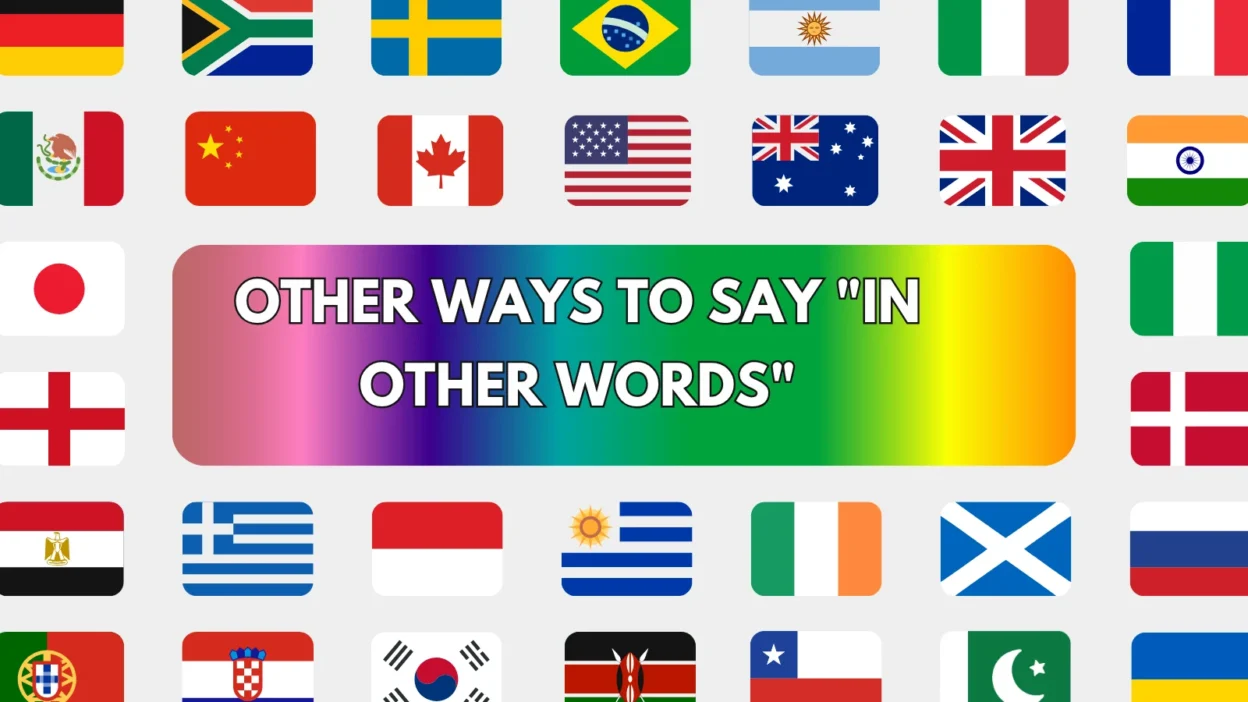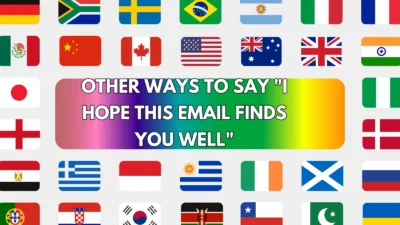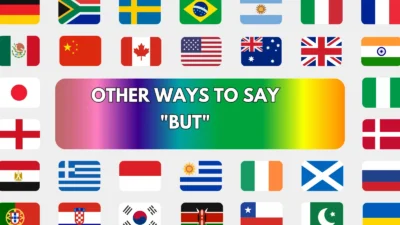The phrase “in other words” is a helpful tool for clarifying, rephrasing, or simplifying a statement. It’s often used in writing and speech to restate something in a clearer or more understandable way. However, using the same phrase too often can make your communication feel repetitive or dull.
To add variety and refine your tone, try replacing it with different expressions that serve the same purpose but match different styles, audiences, and situations. Below are 25 clear and useful alternatives to “in other words” — each explained with meaning, examples, and ideal use.
1. To Put It Simply
Meaning:
Used to simplify a complex idea or explanation.
Detailed Explanation:
This phrase shows you’re about to make something easier to understand. It’s perfect when your audience may not be familiar with the topic.
Scenario Example:
The system’s backend failed to process user inputs. To put it simply, the website broke.
Best Use:
Presentations, teaching, general explanations.
Tone:
Clear, helpful, accessible.
2. That Is To Say
Meaning:
Used to clarify or rephrase a previous point more precisely.
Detailed Explanation:
This phrase is slightly formal and ideal for detailed writing or explanations.
Scenario Example:
He’s a polyglot — that is to say, he speaks multiple languages fluently.
Best Use:
Academic writing, reports, essays.
Tone:
Formal, explanatory, precise.
3. Simply Put
Meaning:
A brief and clear way of introducing a simplified version of something.
Detailed Explanation:
It’s short, direct, and great for business or public speaking.
Scenario Example:
Simply put, we’re spending more than we’re earning.
Best Use:
Presentations, business memos, public communication.
Tone:
Concise, clear, professional.
4. In Simpler Terms
Meaning:
Used to introduce a more basic version of a complex explanation.
Detailed Explanation:
This helps when explaining technical or unfamiliar information to a general audience.
Scenario Example:
In simpler terms, the app translates your voice into another language instantly.
Best Use:
Educational settings, customer communication.
Tone:
Clear, instructional, friendly.
5. To Clarify
Meaning:
Indicates you’re about to restate something to avoid confusion.
Detailed Explanation:
Great for polite corrections or when you notice someone misunderstood.
Scenario Example:
To clarify, the offer ends next Monday, not this Friday.
Best Use:
Emails, formal writing, support replies.
Tone:
Professional, respectful, helpful.
6. To Rephrase It
Meaning:
Introduces a restatement using different words.
Detailed Explanation:
Useful when restating a sentence to make it more effective or easier to understand.
Scenario Example:
To rephrase it, we should invest more time in training our staff.
Best Use:
Workshops, discussions, technical writing.
Tone:
Neutral, explanatory, supportive.
7. What I Mean Is
Meaning:
Used to clarify something that might not have been understood correctly.
Detailed Explanation:
Sounds conversational and personal, ideal in discussions or casual writing.
Scenario Example:
What I mean is, we need to act now before the situation worsens.
Best Use:
Conversations, speeches, storytelling.
Tone:
Casual, explanatory, personal.
8. Put Another Way
Meaning:
Signals that you’re expressing the same point in a different form.
Detailed Explanation:
Useful when the first explanation may have been too complex.
Scenario Example:
Put another way, we can’t move forward without leadership’s approval.
Best Use:
Professional writing, teaching, reports.
Tone:
Clear, straightforward, polite.
9. Stated Differently
Meaning:
Means the same thing, just worded another way.
Detailed Explanation:
This phrase sounds professional and is perfect in writing that requires clarity.
Scenario Example:
Stated differently, the budget doesn’t allow for additional expenses.
Best Use:
Business reports, academic writing.
Tone:
Formal, precise, polished.
10. To Sum Up
Meaning:
Used when you’re about to give a simplified summary.
Detailed Explanation:
Great for ending explanations in a concise way.
Scenario Example:
To sum up, we need more time and better tools to succeed.
Best Use:
Presentations, conclusions, overviews.
Tone:
Summarizing, clear, helpful.
11. As In
Meaning:
Introduces an example or simpler definition of the previous idea.
Detailed Explanation:
Very natural in spoken language and simple writing.
Scenario Example:
He’s inconsistent — as in, he shows up late nearly every day.
Best Use:
Conversations, informal writing.
Tone:
Casual, informal, easygoing.
12. More Specifically
Meaning:
Narrows down or adds detail to the prior point.
Detailed Explanation:
Helpful when you want to explain part of a general idea more deeply.
Scenario Example:
More specifically, we need funding for marketing and product testing.
Best Use:
Detailed writing, proposals, explanations.
Tone:
Professional, detailed, specific.
13. In Clear Terms
Meaning:
Used when you’re making something as plain as possible.
Detailed Explanation:
Useful when eliminating ambiguity or confusion.
Scenario Example:
In clear terms, we cannot proceed without stakeholder approval.
Best Use:
Public messaging, instructions, policies.
Tone:
Direct, serious, clear.
14. In Plain English
Meaning:
Describes technical or complex ideas in easy-to-understand language.
Detailed Explanation:
Often used to break down jargon into everyday speech.
Scenario Example:
In plain English, it means your account is overdrawn.
Best Use:
Customer service, education, user instructions.
Tone:
Simple, informal, helpful.
15. What That Means Is
Meaning:
A way to explain the meaning of something just said.
Detailed Explanation:
Very natural in spoken language and helpful for clarification.
Scenario Example:
The server is overloaded. What that means is your request might be delayed.
Best Use:
Verbal explanations, support conversations.
Tone:
Informal, explanatory, clear.
16. Essentially
Meaning:
Used to capture the core meaning of something.
Detailed Explanation:
Helpful when condensing a longer idea into a few words.
Scenario Example:
Essentially, we’re doing the same work with fewer resources.
Best Use:
Business writing, summaries.
Tone:
Neutral, thoughtful, concise.
17. In Short
Meaning:
Gives a brief version of what was just said.
Detailed Explanation:
Perfect for summing up a long or detailed explanation.
Scenario Example:
In short, we need a new strategy.
Best Use:
Conclusions, summaries, summaries in presentations.
Tone:
Clear, concise, summarizing.
18. So To Speak
Meaning:
Used to clarify that you’re using a figure of speech or metaphor.
Detailed Explanation:
Adds color or metaphorical meaning to your rephrasing.
Scenario Example:
We’ve hit a wall, so to speak, in our negotiations.
Best Use:
Creative writing, discussions, blogs.
Tone:
Playful, figurative, informal.
19. To Say It Differently
Meaning:
A phrase to introduce the same idea in another form.
Detailed Explanation:
Useful when you want to make your point clearer or more relatable.
Scenario Example:
To say it differently, we need to rethink the entire plan.
Best Use:
Business writing, teaching, discussions.
Tone:
Neutral, practical, direct.
20. In Summary
Meaning:
Used when summing up the core idea in brief.
Detailed Explanation:
Commonly used in writing to conclude or restate in fewer words.
Scenario Example:
In summary, the client is requesting a full redesign.
Best Use:
Reports, presentations, formal communication.
Tone:
Professional, clear, summarizing.
21. Which Means
Meaning:
Introduces the result or implication of the previous idea.
Detailed Explanation:
Very natural and conversational — helps explain what something leads to.
Scenario Example:
He missed the meeting — which means we’ll need to reschedule.
Best Use:
Conversation, informal writing.
Tone:
Casual, explanatory, clear.
22. In Layman’s Terms
Meaning:
Explain something technical in language for the average person.
Detailed Explanation:
Especially helpful when communicating with non-specialists.
Scenario Example:
In layman’s terms, it’s like a giant filing cabinet that stores your photos.
Best Use:
Educational, tech-to-client explanations.
Tone:
Friendly, simplified, helpful.
23. Better Yet
Meaning:
Introduces a clearer or improved version of a previous idea.
Detailed Explanation:
Used when rewording something to offer a better explanation or suggestion.
Scenario Example:
We could reschedule — better yet, let’s move it to next week.
Best Use:
Persuasive writing, suggestions.
Tone:
Positive, confident, informal.
24. Namely
Meaning:
Specifically identifies what you just referenced in general terms.
Detailed Explanation:
Adds formality and clarity when narrowing your explanation.
Scenario Example:
We need to address the major issues — namely, the budget and the deadline.
Best Use:
Formal writing, academic texts.
Tone:
Precise, formal, structured.
25. More Precisely
Meaning:
Used to correct or clarify a previous statement with more detail.
Detailed Explanation:
This expression refines or narrows your original explanation.
Scenario Example:
More precisely, we’re targeting customers aged 25 to 35.
Best Use:
Research, analysis, professional writing.
Tone:
Formal, accurate, technical.
Conclusion
The phrase “in other words” is helpful — but using it repeatedly can weaken your writing or speech. By using these 25 sharp and effective alternatives, you can keep your communication clear, dynamic, and better suited to your audience and tone.




